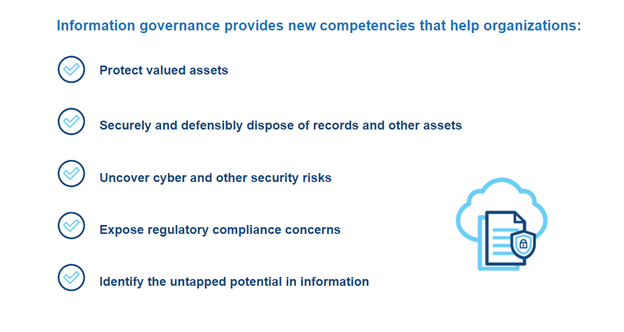
Polishing Rough Diamonds: How Information Governance Boosts AI-Driven Innovation
Information Governance | Artificial Intelligence (AI)
With AI-centric use cases expanding to extract value from both physical and digital assets, it’s time to see information governance as a way to accelerate innovation.
We can learn a lot from diamonds, the universal symbol of strength and love. But they require shaping and polishing to reveal their beauty, brilliance, and economic value. After polishing, a diamond’s value doubles, comprising a global market value of USD 28 billion.
Diamonds are a great metaphor for information in organizations today. Information is a hidden gem, most often in “rough” form where its “polished” value is difficult to see, extract, and fully leverage. Organizations that are not polishing and tapping into the value of information in their physical and digital assets may face a steep opportunity cost as competitors embrace a new wave of artificial intelligence (AI) use cases and capabilities.
AI-powered use cases such as AI-driven automation, generative AI, and immersive experiences rely on digital native data and information digitized from physical and analog assets such as paper, tapes, film, microfiche, even facility and IT equipment. Because most organizations today don’t think of this digitized data and how it can feed AI uses, they need to take a strategic look at how the shift in AI toward blending digital and physical worlds affects the need for an information governance strategy across all their valuable assets.
Information governance is a way to polish and hone information across all sources and in all formats, apply policy to it, and make it accessible for use with AI applications. Gartner asserts that “information governance has never been more critical to business success.” While many people I’ve spoken with over the years think of information governance as a means of putting the brakes on innovation initiatives, I’ve seen information governance be a game-changer for organizations. Across industries, organization types, and company sizes, innovation has helped unlock economic value via new sources of revenue and newfound efficiencies. Today, with the influx of new types of AI use cases, information governance is even more of a mandate.
What is information governance?
In the simplest terms, information governance is a methodology for handling decisions and information that helps businesses attain their goals
Gartner describes information governance as “the specification of decision rights and an accountability framework to ensure appropriate behavior in the valuation, creation, storage, use, archiving, and deletion of information. It includes the processes, roles and policies, standards, and metrics that ensure the effective and efficient use of information in enabling an organization to achieve its goals.”
Information governance has many purposes, which include information protection and the readiness of information to be used in novel ways. For example, if your organization deals with personally identifiable information (PII), you must know where all of your PII is to safeguard it properly. Without information governance, there is an incomplete understanding, or map, of where information resides, what it consists of, how it was collected, who has verified its accuracy and authenticity, who should have access to it, how long it should be retained, whether it can cross geographic boundaries, how it must be disposed of, and so on. The same is true of data from any source that can be used to train AI models and of information and content output from AI applications.

Accessing valuable information quickly
Extracting value from information depends on many factors, including being sure that it is relevant, accurate, complete, and otherwise fit for purpose and can be accessed in time to have value. AI operates with massive amounts of data which has value that may diminish over time, and many organizations struggle with timeliness because they store large volumes of “trash” that obstructs access to and use of valuable data.
Frankly, when organizations have a large volume of clutter, it becomes difficult to find anything, including the opportunity to monetize information that is already owned by an organization (a “sunk cost”).
Clean your closet or buy a bigger one?
You may be wondering, “What are the organizational obstacles to embracing information governance? Why doesn’t everyone do it?” Some organizations believe that buying additional storage to house their growing inventory of information is a “shortcut.” But the information just sits, gathering dust. The get-more-storage approach incurs additional costs, can cause audit non-compliance and increased legal risk, and more importantly, ignores AI and the economic opportunities of leveraging high-value assets.
Cleaning your closet makes sense. It’s discovering what your organization has stored–sometimes for decades–in ways that no longer serve them (how about the 2003 “Holiday Box” containing office party decorations or the “Summer 2006 Interns” box)? Deciding what to digitize and what to keep in its current form, physical or digital, has not always been a priority for many organizations. They don’t have the skills or resources to step back and take a strategic view of their assets at this pivotal moment when AI is becoming ubiquitous.
A new era of information governance is here
Information governance professionals have helped organizations weather the advent of the Internet, the Internet of Things, social media, and many other shifts. A new era of information governance is here. Leading organizations are embracing it to generate new AI-powered use cases, create revenue opportunities, and improve cost efficiencies–all in the name of competitive advantage.Information is a diamond in the rough, and information governance can help unlock its value and advance AI use cases. At Iron Mountain, we help organizations recognize and realize the tremendous potential of organizing and leveraging information to build a stronger, AI-powered future.
About Robert Gerbrandt
Robert is the Global Head of Information Governance at Iron Mountain. He is an accomplished Executive Leader and Management Consultant with broad based experience across industries and geographies. P&L accountability $25-50 Million annual revenues, including sales/new business development. Expanding the consulting capabilities and practices across five global regions. Leading international teams to develop and enhance Iron Mountain Information Governance services and solutions. Proven ability to develop and implement robust governance, risk and compliance practices including policies, processes, and procedure structures for clients in public and private sectors while enhancing their capacity to effectively manage their information assets, including implementation of technologies. Led integrated teams combining onsite, near and offshore resources from the client location, including development, testing and support functions with team sizes in excess of 200 persons. Defined and implemented account management practices that reflect transparent communications, routine expectation management and opportunity identification.


